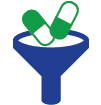In order receive subsidy payments for eligible expenses, retirees must be submitted to the CMS for approval. No matter how meticulously kept eligibility records may be, it is almost certain that there will be members who are “rejected” even if they fit the eligibility criteria for the program. So what’s going on?
The Medicare Database is the source of truth for determining RDS eligibility, which means if the information submitted to establish member eligibility (name, date of birth, social security number, etc.) is not an exact match to Medicare’s database, the member is rejected. Even more frustrating is the limited explanation for the rejection, which consists of a numeric code that corresponds to a vague rejection rationale. That’s it. But we can help.
Whether a Plan Sponsor is interested in traditional RDS services or looking to ensure their subsidy payments from previous years were maximized, for Part D Advisors, the process begins with improving member eligibility. To do this, PDA’s expert Business Analysts track down and consolidate member claim data from every possible source in a secure, customizable fashion. This data, once passed through quality assurance checks and loaded into PDA’s proprietary system, is used to assist Plan Sponsors with increasing their Retired Medicare Eligible Individual (RMEI) count by identifying members who were previously overlooked, leading to increased subsidy payments. Best of all, PDA can receive data through a variety of methods and can work with any file format, reducing the strain on clients and vendors.

 Area One | Member Eligibility ▼
Area One | Member Eligibility ▼  Area Two | Claims Matching ▼
Area Two | Claims Matching ▼  Area Three | Drug Filtering ▼
Area Three | Drug Filtering ▼